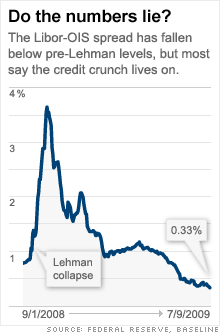Sorry Mr. Greenspan, credit is still tight
A key measure of credit market sentiment is back to 'normal,' according to Alan Greenspan, but consumers say otherwise.

NEW YORK (CNNMoney.com) -- Former Federal Reserve Chairman Alan Greenspan said the credit crunch should be over by now. But just ask anyone who has tried to get a loan recently, and they'll tell you a different story.
Greenspan's measure of credit flow, a gauge known as the Libor-OIS spread, fell to 0.33 percentage points on Thursday -- its lowest level since February 2008 and just eight-hundredths of a point above the 0.25 level that the Maestro called "normal."
So are things back to normal? There's no easy answer.
"It's more complicated than that, obviously," said Scott Anderson, senior economist at Wells Fargo. "Greenspan's right in one respect: the liquidity crisis is over. But consumers' and business' access to credit remains extremely tight."
The "credit crunch" began in the fall of 2007, when the housing market began to unravel and the value of many mortgage-backed securities, held by most banks, started to tumble. With losses piling up at financial institutions, banks tightened their lending standards and offered more conservative loan products to customers.
The crunch escalated into a "liquidity crisis" last September, after Lehman Brothers collapsed, worrying banks that their lending partners might not be around when it came time to repay their loans. Banks sat on their reserves, interbank lending came to a virtual standstill, and the premium on short-term loans went sky-high. Banks turned to issuing debt rather than making loans to stay afloat.
The crisis has passed, experts say. But the crunch is here to stay for awhile.
Why the liquidity crisis is over. Beginning in October, the Fed unveiled nearly a trillion dollars in liquidity programs, and the Treasury Department lent hundreds of billions of dollars in TARP funds to banks. Both efforts were aimed at getting banks to lend to one another again.
Experts say the programs have largely worked: Banks have started repaying their TARP funds, interbank lending has increased and the Libor-OIS spread has fallen back to normal.
The Libor-OIS spread is a good credit market gauge because it measures the difference between what banks are actually charging each other for three-month loans and what traders believe the baseline Fed rate will average over the course of the loan.
Banks charge a lot more than the Fed wants them to charge when credit is tight, because of supply and demand: When no one is issuing loans, they can charge whatever they want. When everyone is lending, they have to be competitive.
"The systemic risk in the banking system has been mitigated," said Andrew Brenner, senior vice president of MF Global. "There's been huge move away from banks having to issue debt to stay alive, and banks that were firing are hiring again."
The spread averaged 0.11 percentage points over the four years before August 2007. That increased to about 0.85 points just before Lehman's meltdown. In mid-October, before TARP was doled out and the Fed's liquidity programs began, the spread rose to a record 3.65 points. But it has fallen steadily since then.
Why the credit crunch is still here. If banks are healthier, why haven't we noticed?
Mostly, because the economy still stinks. With unemployment levels closing in on 10%, household wealth deteriorating, foreclosures still rising and credit delinquencies at a record high, banks aren't quite ready to fork over their dough to you without being absolutely sure you can pay it back.
Accordingly, the Fed reported Wednesday that consumer borrowing fell by $3.22 billion in May after dropping a record $16.5 billion in April.
Furthermore, just because liquidity is essentially back to normal, that doesn't mean that financial institutions are healthy again. Losses are still mounting, markets are still volatile and banks are still hanging onto billions of dollars in toxic assets.
"There's a long way to go," said Anderson. "Banks still have a lot of losses to make up."
Will it get better?
"Absolutely. Everything goes in cycles," said Brenner, who predicts the credit crunch will end in about a year. "These low rates will probably spur inflation at some point, and banks will make more money."
But some aren't so sure the future will look like the past.
"It won't ever go back to the way it was before the crisis erupted in the fall of 2007," said Anderson. "There's a new normal as far as banks are concerned, in terms of tighter standards and the types of loan products offered." ![]()

